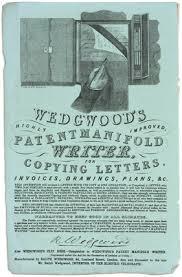The Manifold Writer
The Manifold Writer copying device has been mentioned previously on WWW web pages, in connection with letters written in the 1840s to the Eastern Cape shopkeeper Mrs Harriet Townsend, by a Cape Town import merchant who supplied her with goods, Mr Smith. [See here the Curiosity on ‘When is a letter?‘.] Ever since I came across the Manifold Writer when working on the collection that these letters are part of, it has intrigued me both as a mechanical reality and also as a metaphor for aspects of letter-writing, indeed of writing ‘full stop’. It is this latter aspect in particular that is commented on here, although disentangling this from the mechanics and how these are used in practice is by no means easy. As a consequence, while complete in its own right, this blog is best read in association with the Curiosity referred to above.

The Manifold Writer appeared on the scene in the later 1830s, although it was not the first mechanical copying device to have been invented. It was, however, one that was taken up with some alacrity both in a business and organisational context and also, given its smart and portable appearance as shown in the advertisement for it accompanying this blog, more widely too. The specific technology used for copying, involving pressure from a pen or pencil, was an inked sheet similar to carbon paper held in frame in a leather case. A version of carbon paper had been invented considerably earlier, but did not really take off as a stand-alone item until the 1870s when the typewriter came on the scene and the ink and wax kind of carbon was replaced by a film sheet.
The Manifold Writer was a new technology in the 1840s age of handwritten letters and other documents. It was seized upon by Mr Smith, who commented in some detail about it in his first ‘manifolded’ letter to Harriet Townsend, dated 3 May 1843 (Pringle Collection, Cory Library). This was because he recognised that it would enable him to keep track of his business and other transactions without either memory playing him false or having to hand-write out a copy in full. As it turned out – that is, in the specific practices he engaged in when using it – he was also able to use it ‘do things’ with his letter-writing that had not really been possible before, a number of which are discussed in the above mentioned blog and will not be repeated here.
The Manifold Writer, or indeed any other mechanical copying device, works by producing a copy through, and at the same moment of, ‘writing itself’. In the case of letter-writing, this does things with and to ‘the letter’ because it changes the form in some fundamental ways. It changes what ‘writing’ consists in. In doing so, it signifies a start to the age of mechanical reproduction, and it produces ‘a copy’ which is largely indistinguishable from ‘a letter’ seen as the ‘original’. Indeed, in a sense it is the original, for it has been produced by the same hand, making the same strokes with pen or pencil, holding the same paper, seeing the same words unfold as the hand moves on the paper. But at the same time it is not; it is a kind of shadow-version of itself, a literal underside. It is in fact a simulacra, and while it can (usually) be told apart from its ‘top’, this is only because of differences in ink.
An easily available and portable copying device changed the ontological basis of letter-writing and letter-sending in another respect too. Letters are written in order to be sent, to be dispersed among the different addressees with whom the letter-writer is in correspondence. Without copies, for the letter-writer there is dispersal, memory and recollection, and shreds and hints of what they wrote that may appear ghost-like in replies to their letters written by their addressees. But for these recipients, there is the possibility of amassing the letters someone has sent to them and producing ‘a collection’ of them. This has been the origin and the fate of the many letters in South African collections that the WWW project is concerned with.

Copying, however, makes ‘a collection’ possible for the letter-writer too, albeit one which has an ontologically different character from that which can be amassed by an addressee. Who has the ‘original’, who has the ‘real’ letter or other document, here? On one level, this is self-evidently the person to whom the letter was addressed, who received and read it, and who then saved and ‘collected’ it. On another, there are complexities here which trouble such apparent certainties: the ‘copy’ was written at the same time by the same hand using the same pen or pencil exerting the same mindful pressure on the paper. And so, while yes of course there is a difference made by sending one version of this and knowing that it was received and read and thought upon, this should not be to the exclusion of recognising the difference made by keeping and collecting another version written at the same time by the same letter-writer to the same addressee.
The act of writing, the act of sending, the act of remembering, are all changed in the age of mechanical reproduction. When someone like Mr Smith habitually used a Manifold Writer copying device, is what he posted the original? Yes; but just part of it, and so also no. And was there the dispersal of such a person’s letters far and wide? Yes, certainly; but also no, not entirely. Who remembers what was written? No need to, just get it out and (re)read it.
Letters are typically part of what Michel de Certeau has called a ‘writing laboratory’, because people who write usually do so in a number of everyday ‘documents of life’ genres, such as letters, notes, invoices, memos, cards and so on (and presently, also in text, email etc as well). In this respect, they are in their own selves ‘manifold writers’ in a symbolic sense because writing in manifold ways (and for the Forbes family as an example, see Liz Stanley [2016] ‘Settler colonialism and migrant letters: the Forbes family and letter-writing in South Africa 1850–1922’, Sociology, 49: 837-52). However, the Manifold Writer device and its treading along the original/copy dividing line had additional, literal, effects. Other products of a writing laboratory in addition to letters could also be produced in a simulaneous writing/copying way, so long as they fitted, or could be made to fit, the material form of the device, while others had resistant aspects.
The things that did not fit in a literal sense were, particularly, bound books of various kinds, such as ledgers for keeping accounts, books of dockets and Notes pages of year- and engagements-diaries. Later, by the 1880s or 90s, these were widely printed with carbons, indicating that it was their literal rather than their symbolic form that had inhibited if not entirely prevented copying earlier.
Some other forms or genres of writing were resistant in a deeper sense, however, including such things as deeds, maps of property and Wills, with this bound up in the legalities governing these. In this framework, notions of what was ‘original’ and what was ‘copy’ were rigourously perceived and followed. This could include even hand-written and in all detectable respects identical documents, such as for instance two identical Wills, each with appropriate legal seals on them and each duly signed and witnessed, but with one marked ‘Copy’ (also in the Pringle Collection).
What this indicates is that notions of originality or otherwise are predicated upon the purposes to which documents are put and the contexts this occurs in, not just their ‘on the surface’ appearance. And the tests of this are narrow and specific in some circumstances, highly formal and consequential ones, but not in others. What is at the basis of this is the perceived character or quality or being of these written forms, their ontology. And the existence of simulacra forms – both older ones such as hand-copying, and newer ones such as the products of devices like the Manifold Writer – throw up both possibilities and also severe problems for notions of the original, real, true and valid.
A brief coda here on the ‘cc’ line in an email: Screen writing – writing as it appears on a screen as fingers move on a computer keyboard, rather like writing as it appeared on two sheets of paper with carbon between them as fingers moved on a typewriter keyboard – is a fancy, electronic and digital, contemporary, version of what happened when Mr Smith used his Mechanical Writer to write a letter and make a copy of it at one and the same time. But. But there is also a profound difference. In this latter case, there is no original and no copy. The idea of mechanical reproduction no longer has validity because there is no reproduction, only production and production and production and…
But, for every ‘but’ there is always another ‘but’ possible. While digitally there are no longer originals and copies, there can still be simulacra of such. And this is the case with email: the ‘cc’ line gives it away. Carbon Copy. But carbon copy in a context in which there is no original and no copy and no carbon. Wikipedia has some halfway interesting things to say on carbons: click here to read the entry.
Last updated: 4 August 2016





